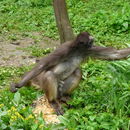Biology
provided by Arkive
The variegated spider monkey has a complex social system, living in multi-male, multi-female “fission-fusion communities” of 3 to 22 individuals. These groups break up into smaller subgroups to forage, and have a home range of around 260 to 390 hectares. A wide variety of calls are used, including 'ts chookis', whoops and wails to locate other subgroups. When two subgroups reunite there is an excited greeting display, which involves vocalizing, chasing, hugging with tails entwined, and sniffing of the sternal glands. This diurnal species is active during the day, foraging primarily for ripe fruit, although also supplementing the diet with decaying wood, leaves and flowers. If potential predators are sighted, individuals shake branches at them to scare them off (2).
The variegated spider monkey gives birth to single young, after a gestation of 225 days (2). Baby spider monkeys tend to cling to their mother's belly for around the first four months of life, after which they climb to her back, eventually developing enough independence to travel on their own (3). Like other spider monkeys, this species is characterised by a slow reproductive rate, with females typically giving birth to single offspring only once every three to four years (4).
Conservation
provided by Arkive
The hybrid spider monkey (A. h. hybridus) is known to occur in 4 protected areas: Catatumbo-Barí, El Cocuy National Park and Tamá National Park in Colombia, and Guatopo National Park in Venezuela (2). Although not in any protected areas, a refuge remains for the brown spider monkey (A. h. brunneus) in the Serranía de San Lucas in southern Bolívar, which has been identified as an important site for the potential establishment of a national park. A park in the Serranía San Lucas would protect a number of species endemic to the region, including two other threatened primate species, the white-footed tamarin (Saguinus leucopus) and woolly monkey (Lagothrix lagothricha lugens). However, the region has been a centre of civil unrest for years, and census work there would be hazardous, since guerilla groups have placed anti-personnel mines in some parts of the mountain range. Although limiting opportunities for surveys and conservation work, this civil unrest has proved to be a double-edged sword, since it is also probably the reason why forest is still remaining, considering the insatiable destruction of the forests elsewhere across the country (4).
Description
provided by Arkive
Exceptionally long, spindly limbs have inspired the common name of spider monkeys (Atelidae), together with their long prehensile tail that acts almost like a fifth limb. Indeed, their tails have highly flexible hairless tips with skin grooves that help to grip, an adaptation to the spider monkey's strictly arboreal lifestyle. Spider monkeys also possess narrow and thumbless, hook-like hands, with fingers that are elongate and curved (3). The variegated spider monkey ranges in colouration from a light brown to a rich mahogany on the upper surfaces of its body, limbs and head (2). By contrast, the abdomen, inner sides of the limbs and underside of the tail are a paler, buff colour, and a conspicuous white triangular patch marks the forehead (2). While normally light brown, some individuals have been observed with eyes that are a striking pale blue (2).
Habitat
provided by Arkive
Primary rainforest is inhabited, as well as riverine, marsh and semi-deciduous forest. An arboreal species that prefers old, tall trees, where it usually confines itself to the upper levels of the canopy (2).
Range
provided by Arkive
Found in northern Colombia and north-western Venezuela (2). Whilst the nominate subspecies, the hybrid spider monkey (A. h. hybridus), occurs from the right bank of the Rio Magdalena in Colombia into western Venezuela, the brown spider monkey (A. h. brunneus) subspecies is restricted to Colombia, ranging between the lower Rios Cauca and Magdalena (4).
Status
provided by Arkive
Classified as Critically Endangered (CR) on IUCN Red List (1). Two subspecies are recognised: the brown spider monkey (A. h. brunneus) and the hybrid spider monkey (A. h. hybridus) are both classified as Critically Endangered (CR) on the IUCN Red List (1).
Threats
provided by Arkive
Both subspecies of variegated spider monkey are considered to be at enormous risk in Colombia (1), having suffered widely from hunting for food (2), and habitat destruction due to human encroachment and conversion to agricultural land (4). Sadly, the species' large size deems it an easy target for hunters, while its slow reproductive rate and generally low population densities makes it especially vulnerable to population collapses as a result of over-hunting (4). The habitat of the hybrid spider monkey (A. h. hybridus) is patchily distributed and there is a concern that few populations remain that are of an adequate size to be viable in the mid to long term. Populations are failing to be actively managed, even within protected areas. However, the brown spider monkey (A. h. brunneus) does not occur in any protected area, and its population size is thought to be much smaller than that of the nominate subspecies (1). The brown spider monkey (A. h. brunneus) has a small geographic range where forest loss, degradation and fragmentation are unfortunately widespread. Thus, this subspecies has been officially recognised in 2004 and 2006 as one of the world's 25 most endangered primates (4).

